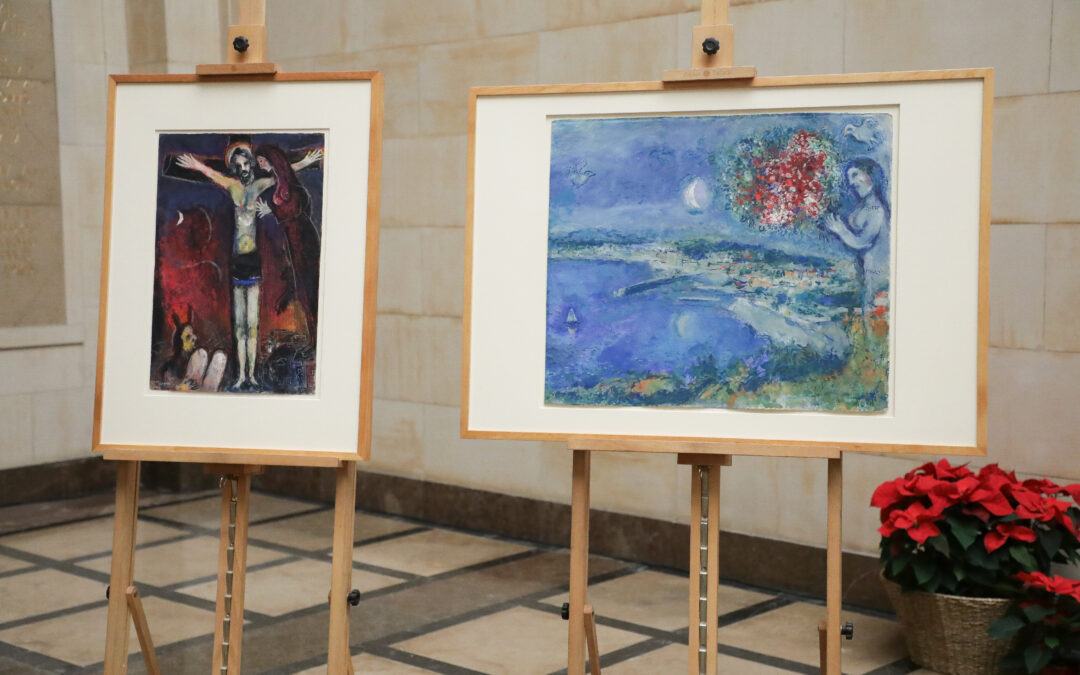A collection of 14 works by Marc Chagall has been purchased by the National Museum in Warsaw, as part of a government strategy to enrich the country’s art collections with important Polish and European pieces.
The pictures, which join two other prints by the Russian-French modernist at the gallery, will be exhibited in the spring of 2022.
The works were purchased by the museum at auction, using a grant from the culture ministry. Neither the ministry nor the museum would reveal the amount paid in response to Notes from Poland’s enquiries, with each suggesting that the question be directed to the other.
“We have enriched Poland’s museum collections with works from the canon of 20th century world art,” said culture minister Piotr Gliński at the unveiling of the pictures. According to the ministry, the works were created during the “heyday of drawing and graphic techniques in Western Europe” in the 1960s and 1970s.
Chagall – who was born in Vitebsk in modern-day Belarus but spent much of his artistic career in France – uses gouache and tempera, crayon, pencil and coloured ink, and even pastel.
The works purchased by the National Museum include – characteristic for Chagall – scenes from the Old Testament, as well as vivid portrayals of couples in love, bouquets of flowers and animals. Some of the paintings refer to the artist’s own childhood.
The works have now been delivered to the museum, but they will only be put up on display in spring 2022. “They will be, along with Pablo Picasso’s work belonging to the museum, the pride of the entire collection,” said museum director Łukasz Gaweł.
The museum already owns two prints by Chagall (illustrations for the autobiography Mein Leben and Nikolai Gogol’s Dead Souls). There are also five prints by the artists at the National Museum in Kraków as well as two of his other works in the eastern city of Lublin.
The culture minister said that the latest purchase constituted part of a long-term strategy to bolster national collections with valuable pieces of European and Polish art. He said investments were ongoing in around 200 museums in Poland.
“On the one hand, we intensively search for our lost or looted art, but on the other, we boldly build new collections, buying works of artists with great names,” said Gliński.
The purchased works include:
- Around the Book of Exodus (1960–1968), gouache, tempera, Indian ink, pastel, coloured pencil, paper
- Crucifixion (1954–1959), gouache, pastel, paper
- “My Life” between Vitebsk and Paris (1954), gouache, Indian ink, pencil, paper
- King David with a harp (1967), gouache, Indian ink, pencil, paper
- Tribute – a large bouquet, (ca 1975), gouache, Indian ink, pastel, tempera, paper
- The Bay of Angels (1971–1978), gouache, pastel, paper
- Fantastic scene on a pink and green background (1978–1980), gouache, Indian ink, pastel, tempera, colour ink, paper
- A Woman with a Red Sun (1961), gouache, pastel, coloured pencil, paper
- Yellow Billy Goat in the Country (1968), gouache, Indian ink, pastel, tempera, pencil, paper
- Pink Valentine’s Day (1978–1980), gouache, pastel, Indian ink, colour ink, paper
- The great spring bouquet on the painter’s table (c. 1978–1980), gouache, colour ink, tempera, pastel, paper
- Light and Fiddler (1979), gouache, pastel, Indian ink, paper
- Visit of Moses and the golden calf in the studio (ca.1976), gouache, Indian ink, colour ink, tempera, paper
- Lilies of the valley for the feast of May 1 in the studio, (c. 1981), gouache, Indian ink, tempera, charcoal, paper
Main image credit: Culture ministry/gov.pl/Press release

Maria Wilczek is deputy editor of Notes from Poland. She is a regular writer for The Times, The Economist and Al Jazeera English, and has also featured in Foreign Policy, Politico Europe, The Spectator and Gazeta Wyborcza.




















